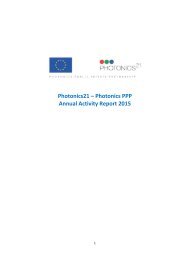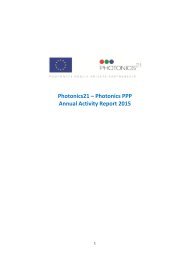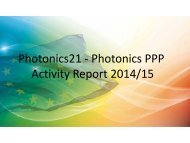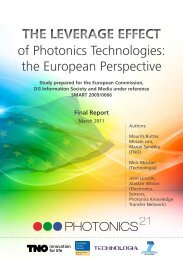Towards 2020 – Photonics driving economic growth in Europe
Create successful ePaper yourself
Turn your PDF publications into a flip-book with our unique Google optimized e-Paper software.
72 <strong>Towards</strong> <strong>2020</strong> <strong>–</strong> <strong>Photonics</strong> <strong>driv<strong>in</strong>g</strong> <strong>economic</strong> <strong>growth</strong> <strong>in</strong> <strong>Europe</strong><br />
<strong>Europe</strong> has taken the lead<br />
<strong>in</strong> develop<strong>in</strong>g <strong>in</strong>tegration<br />
technology platforms<br />
supported by generic foundry<br />
manufactur<strong>in</strong>g, significantly<br />
<strong>in</strong>creas<strong>in</strong>g the effectiveness<br />
and applicability of Photonic<br />
Integrated Circuit technology.<br />
<strong>in</strong>dustries, <strong>in</strong>clud<strong>in</strong>g microelectronics, life sciences,<br />
ICT and advanced manufactur<strong>in</strong>g. Furthermore, it is<br />
vital that we engage and support the full spectrum<br />
of <strong>in</strong>dustrial players, from SMEs to large manufactur<strong>in</strong>g<br />
enterprises.<br />
Major photonic research & <strong>in</strong>novation<br />
challenges<br />
Our vision is built on the foundations of worldlead<strong>in</strong>g<br />
research <strong>in</strong> focused areas that are relevant<br />
to photonics across the board, coupled with <strong>in</strong>itiatives<br />
designed to ensure that the result<strong>in</strong>g technology<br />
is put to use <strong>in</strong> the most efficient and effective<br />
manner. We have identified a number of priority<br />
areas for <strong>in</strong>vestment <strong>in</strong> generic technologies that<br />
will have a high impact across a wide range of<br />
applications, thereby complement<strong>in</strong>g the recommendations<br />
of the applications-oriented work<strong>in</strong>g<br />
groups. These relate specifically to the follow<strong>in</strong>g<br />
areas:<br />
n Photonic <strong>in</strong>tegration, <strong>in</strong>clud<strong>in</strong>g the development<br />
of generic <strong>in</strong>tegration platforms and foundry<br />
models, thereby allow<strong>in</strong>g complex l<strong>in</strong>ear and<br />
nonl<strong>in</strong>ear photonic functionality to be realized<br />
<strong>in</strong> an <strong>in</strong>tegrated form<br />
n Integration of photonics with microelectronics<br />
at the chip, board and system levels<br />
n Technologies for cost-effective manufactur<strong>in</strong>g<br />
of components and subsystems, <strong>in</strong>clud<strong>in</strong>g automated<br />
photonic device assembly and electrooptical<br />
circuit board technology<br />
n Semiconductor optical device technology, with<br />
particular reference to semiconductor lasers<br />
n Exploitation of new materials, <strong>in</strong>clud<strong>in</strong>g new<br />
semiconductors and nanophotonic materials (for<br />
example, metamaterials & plasmonics), multifunctional<br />
fibres, and their associated fabrication<br />
technologies<br />
Our first recommendation relates to photonic <strong>in</strong>tegration.<br />
As <strong>in</strong> microelectronics, many applications<br />
can be addressed <strong>in</strong> a much more compact<br />
and cost-effective way by <strong>in</strong>tegrat<strong>in</strong>g the required<br />
functionality <strong>in</strong> a s<strong>in</strong>gle chip of III-V semiconductor<br />
material (for example, <strong>in</strong>dium phosphide, gallium<br />
arsenide), silicon, or dielectric material. As a result<br />
of past EU <strong>in</strong>vestments, <strong>Europe</strong> has a very strong<br />
position <strong>in</strong> these technologies. Whilst photonic<br />
<strong>in</strong>tegration is one of the most important keys to<br />
competitive advantage, present ways of work<strong>in</strong>g<br />
do not unlock its full potential. Not every supplier<br />
can be vertically <strong>in</strong>tegrated, and access to<br />
technologies by smaller companies, for example,<br />
SMEs, is currently very limited. Furthermore the<br />
large variety of photonic devices and technologies<br />
that have been developed is beg<strong>in</strong>n<strong>in</strong>g to<br />
limit progress <strong>in</strong> the <strong>in</strong>dustry. <strong>Europe</strong> has taken the<br />
lead <strong>in</strong> develop<strong>in</strong>g a new way of work<strong>in</strong>g, based<br />
on <strong>in</strong>tegration technology platforms supported by<br />
generic foundry manufactur<strong>in</strong>g, which can provide<br />
a step-change <strong>in</strong> the effectiveness and applicability<br />
of Photonic Integrated Circuit (PIC) technology.<br />
<strong>Europe</strong>an <strong>in</strong>itiatives on generic photonic <strong>in</strong>tegration<br />
have attracted great <strong>in</strong>terest and are beg<strong>in</strong>n<strong>in</strong>g to<br />
be emulated worldwide, particularly <strong>in</strong> the USA.<br />
It is vital that these <strong>in</strong>itiatives are carried forward<br />
<strong>in</strong> Horizon <strong>2020</strong>, so that the most advanced PIC<br />
technologies are developed <strong>in</strong> the most efficient<br />
way and made accessible for exploitation to the<br />
widest spectrum of end-users. Innovation actions<br />
<strong>in</strong> this area have been specifically identified as a<br />
priority by the applications-oriented work groups,<br />
especially <strong>in</strong> Information and Communications<br />
technology (Work Group 1).<br />
The generic <strong>in</strong>tegration approach has proved<br />
highly successful <strong>in</strong> the microelectronics <strong>in</strong>dustry<br />
and although the challenges <strong>in</strong> apply<strong>in</strong>g the same<br />
methodology to photonics are different and are<br />
<strong>in</strong> some ways greater, we can nevertheless learn<br />
from the microelectronics experience. For <strong>in</strong>stance,<br />
foundry-access programs, such as MOSIS <strong>in</strong> the<br />
USA, had a pivotal impact <strong>in</strong> the development<br />
of the VLSI <strong>in</strong>dustry, not least by tra<strong>in</strong><strong>in</strong>g a large<br />
number of designers <strong>in</strong> circuit design techniques,<br />
and we therefore recommend that a similar approach<br />
should be adopted <strong>in</strong> <strong>Europe</strong> for application-specific<br />
photonic <strong>in</strong>tegrated circuits <strong>in</strong> silicon






